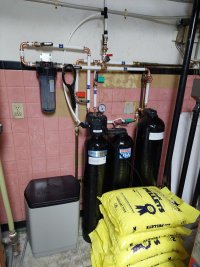Lucky
Member
just had the new kinetico 2030 installed using their dechlorinator. street water goes to dechlorinator then to the sediment filter then the softner. the sediment filter was there from the last installation so i'm not sure if it was easier to plumb that way. or if it really didnt matter. is there any chance that sediment from the street can hurt the declorinator? changing the 4 dollar sediment filter isnt a biggie so i doubt it's put that way to protect that filter.
also now that im studying it more. when it's on bypass it goes from street directly to faucets. i confirmed with pics of my old unit that it was like this before. but even when you bypass (i do fill up a 5 gallon jug once a week with unsoftened water) wouldnt it be a good idea to have it run thru the sediment filter before going to faucet? or heck wouldnt it be nice to go street to sediment to declor then faucet for when i bypass the softner?
also now that im studying it more. when it's on bypass it goes from street directly to faucets. i confirmed with pics of my old unit that it was like this before. but even when you bypass (i do fill up a 5 gallon jug once a week with unsoftened water) wouldnt it be a good idea to have it run thru the sediment filter before going to faucet? or heck wouldnt it be nice to go street to sediment to declor then faucet for when i bypass the softner?

